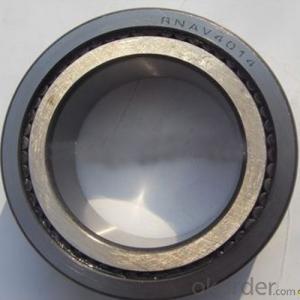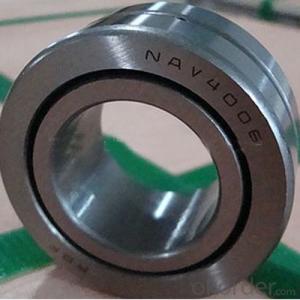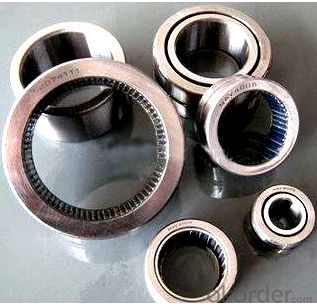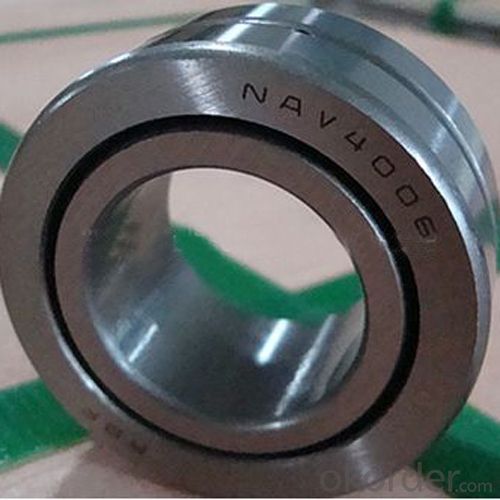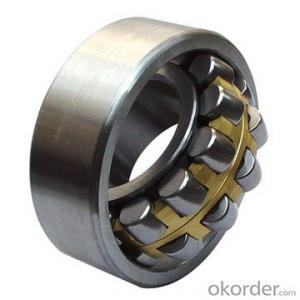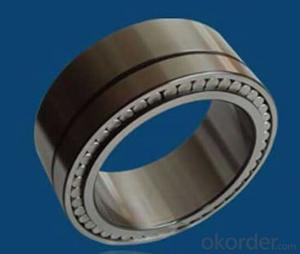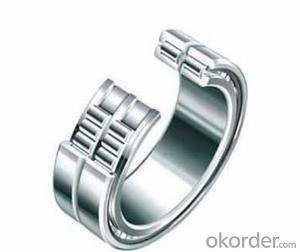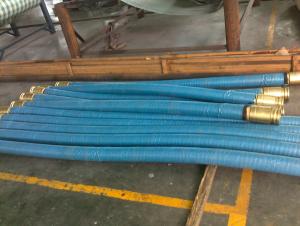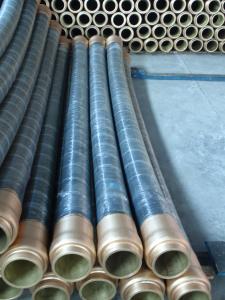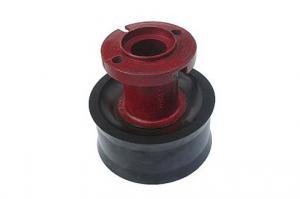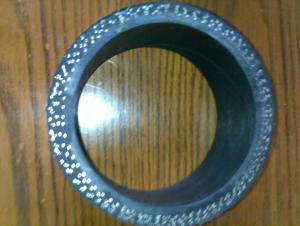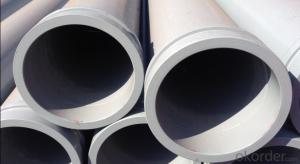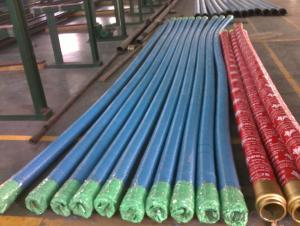Full Complement Needle Roller Bearing III HRC60
- Loading Port:
- Shanghai
- Payment Terms:
- TT OR LC
- Min Order Qty:
- 1 pc
- Supply Capability:
- 1000 pc/month
OKorder Service Pledge
OKorder Financial Service
You Might Also Like
Product information:
As for the full complement needle roller bearing with inner ring,the outer ring has the oil hole.The lubricating oil can be fed in from the oil hole. The outer ring has the double shoulders. As for the full complement needle roller bearing without inner ring,since the inner ring has no shoulder and cage,the inner ring,outer ring,complete set of needles can be mounted respectively.It is s suitable for parts of which the radial size is limited.The surface of shaft journal fitted with it is acted directly as rolling surface.
Size:
NAV190×245×42
RNAV4902
RNAV4002
RNAV4903
RNAV4003
RNAV4904
RNAV4004
RNAV4905
RNAV4005
RNAV4906
RNAV4006
RNAV4907
RNAV4007
RNAV4908
RNAV4008
RNAV4909
RNAV4009
RNAV4910
RNAV4010
RNAV4011
RNAV4912
Salient features:
It is requested that the surface hardness be no less than HRC60,surface roughness,no
more than 0.63μm. This kind of full complement bearing, with inner ring or without inner ring,does not limit the axial shift of shaft and housing.
Since this kind of bearing has no cage,the needles rotate without correct guiding,they rub heavily against each other and the bearing has the low limiting rotational speed.
Packing details:
Standard packing: plastic box inside, carton or wooden box outside
Advantages of our products:
Made from 100% virgin raw material
Produced with advanced equipment
All products go through in-process and final inspection
Free technical service online
About our service:
OEM and ODM orders are welcome
Customized design is available
Reply your enquiry in 24 working hours
Experienced staffs will answer to all your questions in fluent English
Payment terms: we accept T/T, L/C, PayPal, Western Union, Escrow
Regarding T/T payment, the customers need to pay 30% in advance, the balance will be paid off after finished product before shipment
Regarding L/C payment, we just accept the irrevocable L/C, and buyer should pay all handle fee of the bank include our bank handle fee
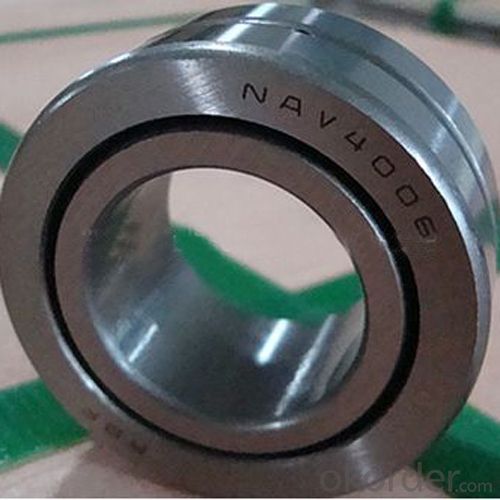
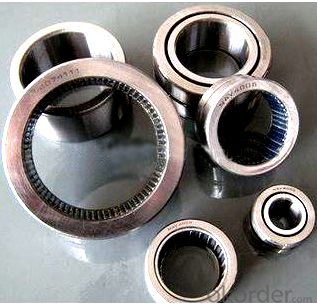
- Q: Are there any specific guidelines for the installation of sensors or transmitters in concrete pump spare parts?
- Concrete pump spare parts have specific guidelines for the installation of sensors or transmitters. These guidelines are crucial to guarantee the sensors or transmitters function properly and provide accurate readings. To start, it is vital to carefully select an appropriate location for sensor or transmitter installation. The chosen location should allow for easy access and maintenance, while also protecting the sensors or transmitters from excessive vibration, moisture, or extreme temperatures. Furthermore, it is advisable to use suitable mounting hardware to secure the sensors or transmitters to the concrete pump spare parts. This hardware should be capable of withstanding operating conditions and any vibrations or shocks that may occur during the pumping process. Additionally, following the manufacturer's instructions for wiring and connection of the sensors or transmitters is essential. Proper wiring and connection ensure accurate and reliable data transmission. Moreover, regular inspections and maintenance are necessary to ensure the sensors or transmitters function correctly. This involves checking for loose connections, signs of wear or damage, and ensuring proper calibration. Overall, adhering to these specific guidelines for sensor or transmitter installation in concrete pump spare parts can enhance performance and durability, ultimately improving the efficiency and safety of concrete pumping operations.
- Q: How often should a concrete pump cleaning ball be used?
- A concrete pump cleaning ball should be used after every pumping job or at least once a day to ensure the cleanliness and proper functioning of the pump. The cleaning ball helps remove any build-up or debris that may have accumulated inside the pump and its pipes during the pumping process. Regular use of a cleaning ball helps prevent clogs and blockages, ensuring a smooth and efficient pumping operation.
- Q: What are the consequences of using substandard concrete pump spare parts?
- Using substandard concrete pump spare parts can have several consequences. Firstly, these parts may not fit properly or have the same level of durability as genuine parts, leading to frequent breakdowns and disruptions in construction projects. This can result in delays and increased costs for repairs or replacements. Secondly, substandard parts may compromise the overall performance and efficiency of the concrete pump. This can lead to decreased productivity, lower quality concrete output, and potential safety hazards for workers. Moreover, using low-quality spare parts can void warranties and insurance coverage, leaving the project owner or contractor liable for any damages or accidents that may occur. Lastly, relying on substandard parts can negatively impact the reputation and credibility of the construction company. Clients may lose trust in their ability to deliver high-quality work, leading to a loss of business opportunities in the future. In conclusion, the consequences of using substandard concrete pump spare parts include increased costs, project delays, compromised performance, safety risks, legal liabilities, and damage to a company's reputation. Therefore, it is crucial to invest in genuine and high-quality spare parts to ensure smooth and efficient construction operations.
- Q: What is the difference between concrete pump and ground pump?
- Ground pump only conveying function, the price is cheaper, and now are used to transport mixing machine, the ground pump is a bit uneconomical
- Q: How do I identify the right spare part for my concrete pump model?
- If you want to find the correct spare part for your concrete pump model, there are several steps you can take: 1. Begin by referring to the manufacturer's manual. This manual is a great starting point because it typically contains detailed information about your concrete pump model and the corresponding spare parts. Look for part numbers, descriptions, and any specific instructions regarding ordering or replacing parts. 2. Conduct online research. Utilize the internet to search for your specific concrete pump model and related spare parts. Many manufacturers have official websites or authorized distributors that provide product catalogs or online databases where you can search for the exact part you need. Look for compatibility charts or diagrams that match your concrete pump model with the appropriate spare parts. 3. Seek advice from a specialist. If you are uncertain about the compatibility or availability of spare parts for your concrete pump model, it is advisable to consult with a specialist. Reach out to the manufacturer's customer service or contact a local distributor or service center that specializes in concrete pumps. Provide them with details about your pump model and the specific part you require, and they should be able to assist you in identifying the correct spare part. 4. Speak with other concrete pump owners. Get in touch with other owners or operators of concrete pumps who have the same or a similar model as yours. They may have experience with finding and replacing spare parts and can offer recommendations or tips on where to search or who to contact. Remember, it is vital to ensure that the spare part you select is compatible with your concrete pump model to prevent any damage or malfunctions. Taking the time to conduct research and seek advice from experts will help you find the appropriate spare part and keep your concrete pump operating smoothly.
- Q: Can concrete pump spare parts be used interchangeably between different pump brands or models?
- No, concrete pump spare parts cannot be used interchangeably between different pump brands or models. Each pump brand and model is designed with specific specifications and dimensions, so the spare parts need to be specifically manufactured to fit those requirements. Attempting to use spare parts from a different brand or model may result in compatibility issues or even damage to the pump. It is always recommended to use genuine spare parts from the same brand or model to ensure proper functioning and longevity of the pump.
- Q: How often should I replace concrete pump spare parts?
- The frequency at which you should replace concrete pump spare parts depends on various factors such as the quality of the parts, the intensity of usage, and regular maintenance. Generally, it is recommended to conduct regular inspections and maintenance to identify any signs of wear or damage in the spare parts. As a preventive measure, it is advisable to replace parts that show significant wear or are no longer functioning optimally. However, it is crucial to follow the manufacturer's guidelines and recommendations for the specific concrete pump model you are using. Additionally, consulting with experienced professionals or technicians in the field can provide valuable insights on the expected lifespan of different spare parts and when replacements may be necessary.
- Q: How can a damaged concrete pump piston affect the pumping efficiency?
- A damaged concrete pump piston can significantly affect the pumping efficiency by compromising the seal between the piston and cylinder. This can lead to leakages and loss of pressure, resulting in reduced pumping force and efficiency. Additionally, a damaged piston can cause irregular movements and vibrations, leading to instability and potential damage to other components of the pump. Overall, a damaged concrete pump piston can hinder the smooth flow of concrete, decrease output, and require more energy to operate, ultimately affecting the pumping efficiency.
- Q: How do I maintain the performance of concrete pump spare parts in extreme weather conditions?
- Maintaining the performance of concrete pump spare parts in extreme weather conditions is crucial to ensure the efficiency and longevity of your equipment. Here are some tips to help you maintain the performance of concrete pump spare parts in extreme weather conditions: 1. Regular inspection: Conduct regular inspections of your concrete pump spare parts to identify any signs of wear and tear. Extreme weather conditions can accelerate the deterioration of parts, so it is important to catch any potential issues early on. 2. Keep parts clean: Extreme weather conditions such as rain, snow, or excessive heat can lead to the accumulation of dirt, debris, or other contaminants on your spare parts. It is essential to clean the parts regularly to prevent any clogging or damage. 3. Proper lubrication: Lubrication is crucial for the smooth functioning of concrete pump spare parts. In extreme weather conditions, it is recommended to use lubricants specifically designed for such conditions. These lubricants should have high viscosity and resistance to temperature fluctuations. 4. Protect from direct exposure: Extreme weather conditions, such as extreme heat or freezing temperatures, can directly impact the performance of concrete pump spare parts. It is essential to protect the parts from direct exposure to these conditions by utilizing covers or enclosures. 5. Store spare parts correctly: When not in use, spare parts should be stored in a dry and temperature-controlled environment. Extreme weather conditions can cause parts to expand or contract, leading to potential damage. Storing spare parts in a controlled environment will help maintain their integrity and performance. 6. Timely replacement: Constant monitoring and timely replacement of worn-out parts are crucial to maintaining the performance of concrete pump spare parts. Extreme weather conditions can accelerate the wear and tear process, so it is important to have a proactive approach towards replacement. 7. Consult the manufacturer: If you are unsure about the specific requirements for maintaining concrete pump spare parts in extreme weather conditions, it is always best to consult the manufacturer. They can provide you with expert advice and guidance on how to ensure optimal performance in such conditions. By following these tips, you can effectively maintain the performance of concrete pump spare parts in extreme weather conditions, ensuring the smooth and efficient operation of your equipment.
- Q: Can concrete pump spare parts be inspected for dimensional accuracy before installation?
- Yes, concrete pump spare parts can be inspected for dimensional accuracy before installation. Before installing any spare parts, it is important to ensure that they meet the required specifications and dimensions to ensure proper functioning and compatibility with the concrete pump system. Inspection can be done using various methods such as visual inspection, measuring with precision instruments, and comparing the dimensions with the manufacturer's specifications. This process helps to identify any discrepancies or deviations in the dimensions of the spare parts, allowing for adjustments or replacement if necessary. Inspecting spare parts for dimensional accuracy before installation helps to ensure the smooth operation and longevity of the concrete pump system.
Send your message to us
Full Complement Needle Roller Bearing III HRC60
- Loading Port:
- Shanghai
- Payment Terms:
- TT OR LC
- Min Order Qty:
- 1 pc
- Supply Capability:
- 1000 pc/month
OKorder Service Pledge
OKorder Financial Service
Similar products
Hot products
Hot Searches
Related keywords
